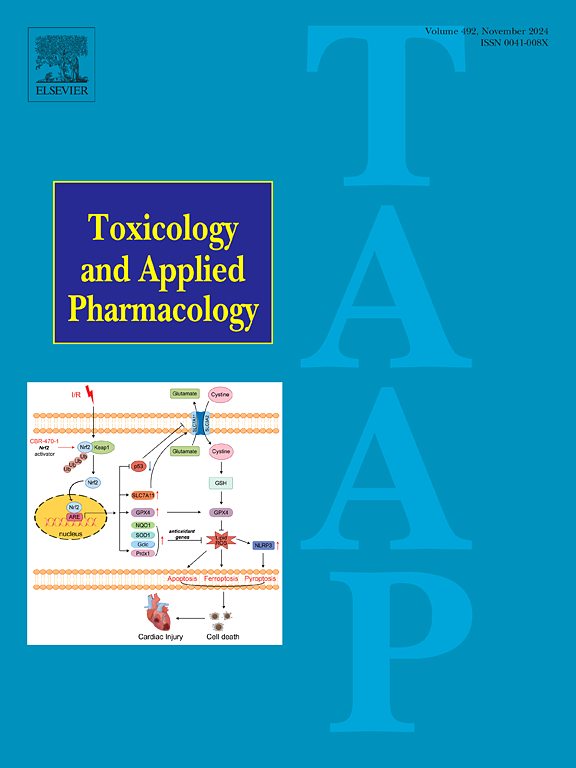Integrated transcriptomics and metabolomics unravel the key metabolic pathways involved in the therapeutic mechanism of Salvianic acid A against hepatic fibrosis
IF 3.4
3区 医学
Q2 PHARMACOLOGY & PHARMACY
引用次数: 0
Abstract
Effective drugs for the clinical treatment of hepatic fibrosis have not yet been identified. Salvianic acid A (SAA) protective mechanisms primarily include anti-inflammation, anti-oxidative stress, and modulation of immune system function. Metabolic dysfunction is well recognized as the driver for hepatic fibrosis. However, the precise action mode and underlying mechanism of SAA in modulating hepatic metabolism to combat hepatic fibrosis remain incompletely understood. This study aimed to investigate the metabolic mechanism by which SAA improves hepatic fibrosis based on metabolomics and transcriptomics profiling. A mouse model of carbon tetrachloride (CCl4)-induced hepatic fibrosis mouse model was established, and protective effects of SAA were evaluated through pathological characteristics. Integrated metabolomics and transcriptomics analysis revealed three key altered metabolic pathways: bile secretion, carbohydrate digestion and absorption, and regulation of lipolysis in adipocytes. SAA modulated the bile secretion pathway, dependent on reducing water channel protein Aqp1, cholesterol synthesis enzyme Hmgcr and Na+/K+-ATPase enzyme Atp1a3, accompanied by up-regulating metabolites glutathione and glucose levels. SAA also regulated carbohydrate digestion and absorption by decreasing the glucose homeostasis-related Akt3, essential enzyme G6pc for gluconeogenesis/glycogenolysis and glucose transporter Atp1a3 with a concomitant increase of metabolites D-galactose, maltose, and sucrose levels. Moreover, SAA improved lipolysis in adipocytes in liver fibrosis through inhibiting lipolysis related Prkg1, lipid transporter Fabp4, lipolysis-associated Akt3 and increasing lipolysis mediator Adrb3, along with upregulated levels of metabolites adenosine monophosphate and norepinephrine. In conclusion, SAA alleviates hepatic fibrosis through modulating metabolic disorders, mainly relying on the metabolic improvements of bile secretion, carbohydrate digestion and absorption and adipocyte lipolysis.

整合转录组学和代谢组学揭示了丹参酸A治疗肝纤维化机制中涉及的关键代谢途径。
临床治疗肝纤维化的有效药物尚未确定。丹参酸A (SAA)的保护机制主要包括抗炎症、抗氧化应激和调节免疫系统功能。代谢功能障碍被认为是肝纤维化的驱动因素。然而,SAA在调节肝脏代谢对抗肝纤维化中的确切作用模式和潜在机制尚不完全清楚。本研究旨在基于代谢组学和转录组学分析探讨SAA改善肝纤维化的代谢机制。建立小鼠四氯化碳(CCl4)致肝纤维化模型,通过病理特征评价SAA的保护作用。综合代谢组学和转录组学分析揭示了三个关键的代谢途径:胆汁分泌、碳水化合物消化和吸收以及脂肪细胞中脂肪分解的调节。SAA通过降低水通道蛋白Aqp1、胆固醇合成酶Hmgcr和Na+/K+- atp酶Atp1a3调节胆汁分泌途径,同时上调代谢物谷胱甘肽和葡萄糖水平。SAA还通过降低葡萄糖稳态相关的Akt3、糖异生/糖原分解必需酶G6pc和葡萄糖转运蛋白Atp1a3来调节碳水化合物的消化和吸收,同时增加代谢物d -半乳糖、麦芽糖和蔗糖的水平。此外,SAA通过抑制脂解相关的Prkg1、脂质转运体Fabp4、脂解相关的Akt3和增加脂解介质Adrb3,以及代谢产物单磷酸腺苷和去甲肾上腺素水平上调,改善肝纤维化中脂肪细胞的脂解。综上所述,SAA通过调节代谢紊乱缓解肝纤维化,主要依赖于胆汁分泌、碳水化合物消化吸收和脂肪细胞脂解的代谢改善。
本文章由计算机程序翻译,如有差异,请以英文原文为准。
求助全文
约1分钟内获得全文
求助全文
来源期刊
CiteScore
6.80
自引率
2.60%
发文量
309
审稿时长
32 days
期刊介绍:
Toxicology and Applied Pharmacology publishes original scientific research of relevance to animals or humans pertaining to the action of chemicals, drugs, or chemically-defined natural products.
Regular articles address mechanistic approaches to physiological, pharmacologic, biochemical, cellular, or molecular understanding of toxicologic/pathologic lesions and to methods used to describe these responses. Safety Science articles address outstanding state-of-the-art preclinical and human translational characterization of drug and chemical safety employing cutting-edge science. Highly significant Regulatory Safety Science articles will also be considered in this category. Papers concerned with alternatives to the use of experimental animals are encouraged.
Short articles report on high impact studies of broad interest to readers of TAAP that would benefit from rapid publication. These articles should contain no more than a combined total of four figures and tables. Authors should include in their cover letter the justification for consideration of their manuscript as a short article.

 求助内容:
求助内容: 应助结果提醒方式:
应助结果提醒方式:


